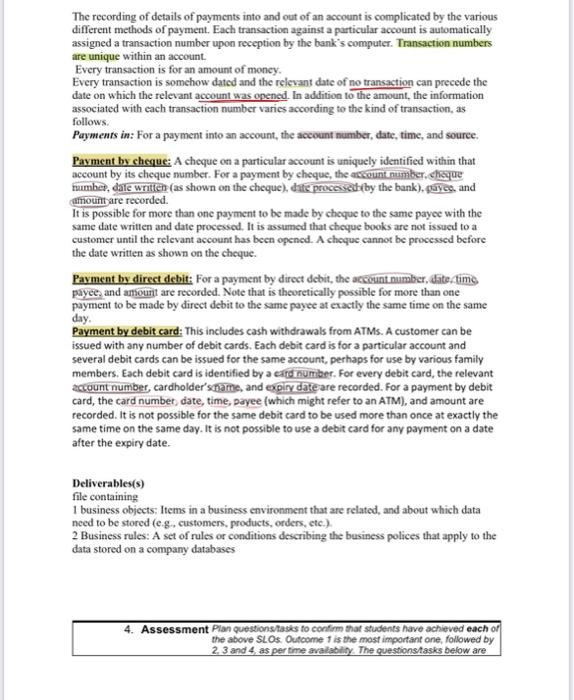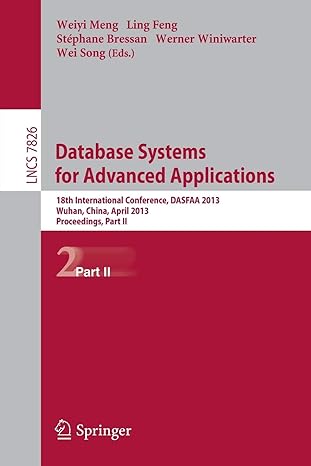please answer the requirements below , outcome A & outcome B

1. SessionPlease list the Session Laaming Oufoomes (St.Os), as presented in the Outcomes ABET Student Outcomes A to K. Note: The sequence of instruction may vary and you may start with the most essential SLO, 1 it the most important one, followed by 2,3 and 4. as per fime avalatility. * Outcome A: Creating Database objects by using Data Definition Language (DDL) 2. Tool(s)/Software MySQL. Workbench 3. procedural steps (Tasks) Description - To determine the data requirements of the database in serms of primitive objects - To classify and describe the information about these objects - To identify and classify the relationships among the objects - To determine the types of transactions that will be executed on the database and the interactions between the data and the transactions - To identify rules governing the integrity of the data Tasks/Assignments(s) Consider the following Scenario and identify the DB Requirements and Business Rules. The bank has customers. Each new customer is assigned a unique customer number. Each customer's name and address must be recorded. Optionally, one e-mail address for a customer can be recorded, as well as up to three phone numbers - but no more than one phone number of each type (home, business, mobile). To become a customer of the bank, one most open at least one account. Of course it is possible for the same customer to have siseral accounts (for example, current, savings, mortgage, and so on). Each account is aniquely identified by an account number. For each account, the account holder's custormer number must be recorded and also the account type, and the date on which the account was opened. The same customer is permitted to hold several accounts of the same type. The recording of details of payments into and out of an account is complicated by the various different methods of payment. Each transaction against a particular account is automatically assigned a transaction number upon reception by the bank's computer. Transaction numbers are unique within an account. Every transaction is for an amount of moncy. Every transaction is somehow dated and the relevant date of no transaction can precede the date on which the relevant account was opened. In addition to the amount, the information associated with each transaction number varies according to the kind of transaction, as follows. Payments in: For a payment into an account, the account number, date, time, and souree. Payment by cheque: A cheque on a particular account is uniquely identified within that account by its cheque number. For a payment by cheque, the acsount number, chisque number, date written (as shown on the cheque), datc procasey(by the bank), payes, and intouintiare recorded. It is possible for more than one payment to be made by cheque to the same payee with the same date written and date processed. It is assumed that cheque books are not issued to a customer until the relevant account has been opened. A cheque cannot be processed before the date written as shown on the cheque. Payment by direct debit: For a payment by direct debit, the account number, Afte. Atime payee, and amount are recorded. Note that is theoretically possible for more than one payment to be made by direct debit to the same payee at exactly the same time on the same day. Payment by debit card: This includes cash withdrawals from ATMs. A customer can be issued with any number of debit cards. Each debit card is for a particular account and several debit cards can be issued for the same account, perhaps for use by various family members. Each debit card is identified by a cild number. For every debit card, the relevant account number, cardholder'snIms, and expiry dateare recorded. For a payment by debit. card, the card number, date, time, payee (which might refer to an ATM), and amount are recorded. It is not possible for the same debit card to be used more than once at exactly the same time on the same day. It is not possible to use a debit card for any payment on a date after the expiry date. Deliverables(s) file containing 1 business objects: Items in a business environment that are related, and about which data need to be stored (e.g., customers, products, orders, etc). 2 Business rules: A set of rules or conditions describing the business polices that apply to the data stored on a company databases 4. Assessment Plan questions/lasks fo confirm that students have achieved each of the above SLOs. Outcome t is the most important one, followed by 2. 3 and 4, as per time avalabilid. The questions/asks below are 4. Assessment Plan questions/tasks to confirm that students have achieved each of the above SLOs. Outcome 1 is the most important one, followed by 2,3 and 4 , as per time availability. The questions/tasks below are iust for guidance and the laboratory instructor can come up with his own questions/tasks. 1. Outcome A: Student will be asked to identify business objects and Business rules 2. Outcome B: Students will be divided into groups to solve the assessment 5. Resources Suggest further resources for the students to manage their leaming after the class. Make sure that the resources are specific and different to suit all students, e. g. Figures, Tables, Links, etc










